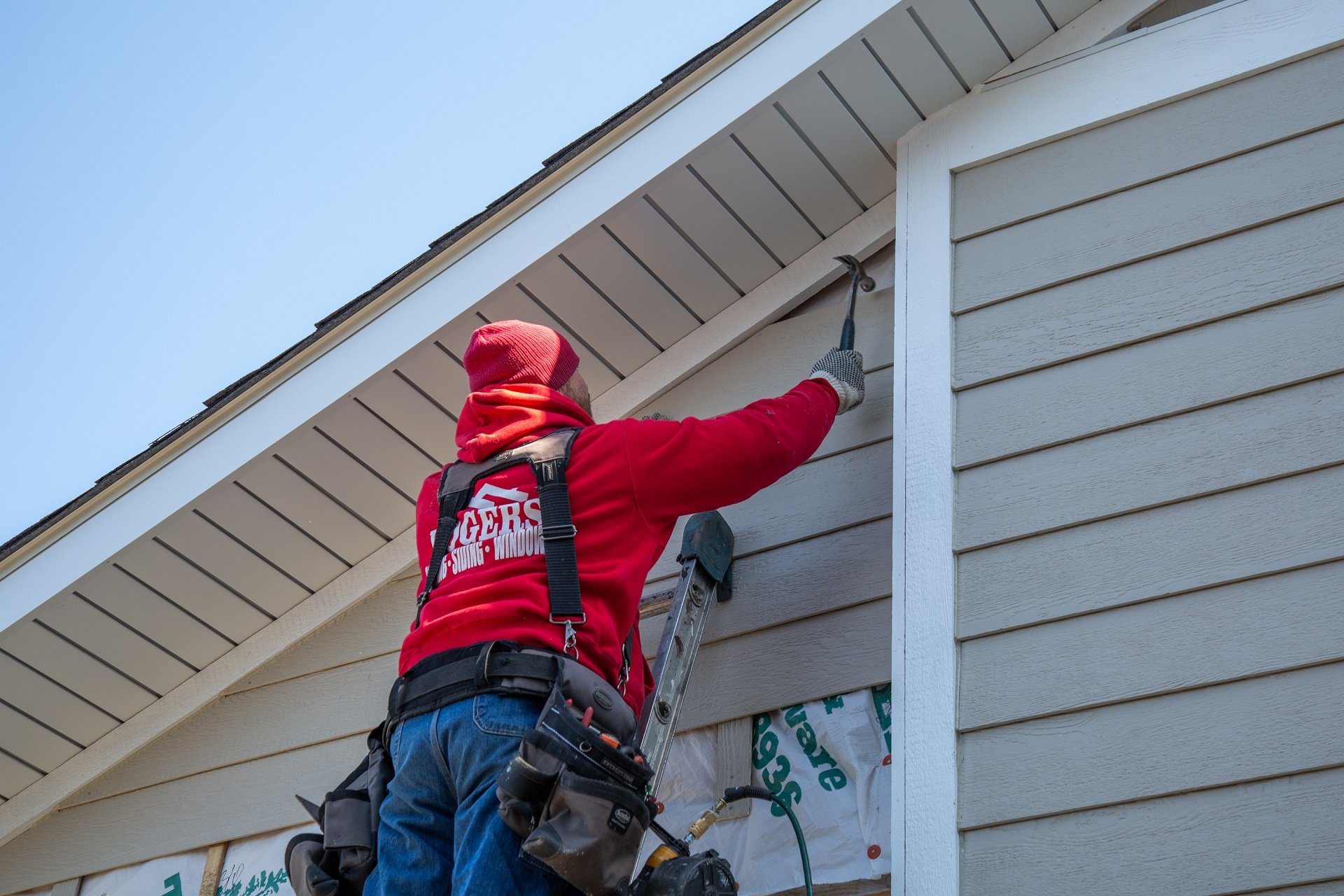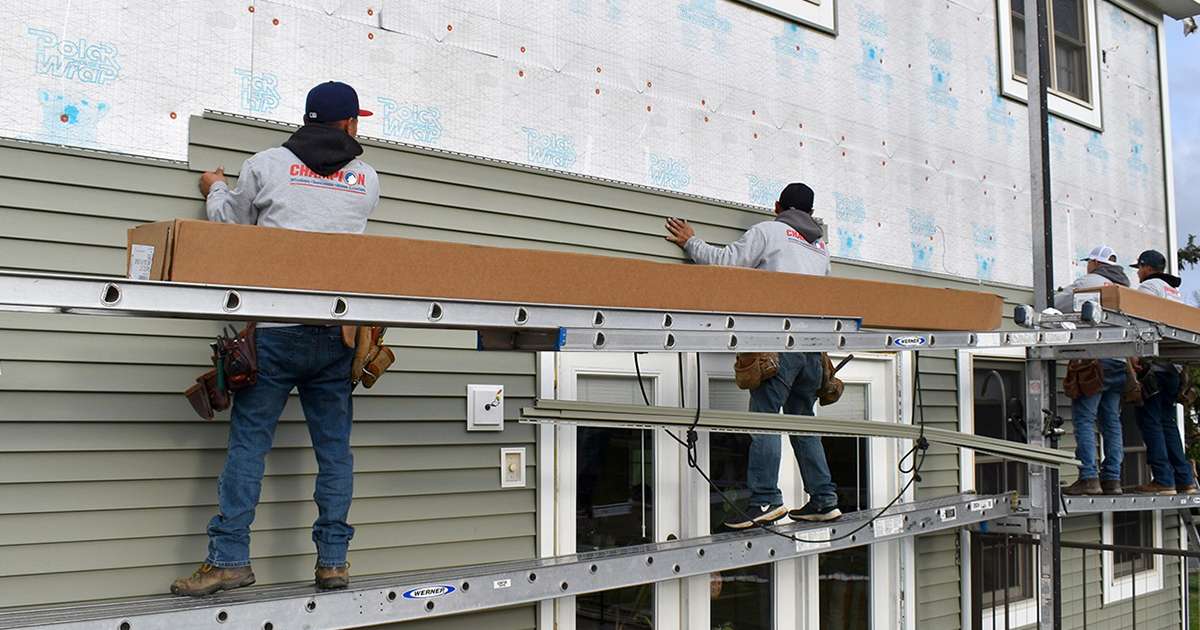The Necessary Guide to the Different Kinds of Exterior Siding and Their One-of-a-kind Benefits
In the realm of home improvement, selecting the right exterior siding is a crucial choice that influences both visual charm and practical performance. With so many alternatives to take into consideration, which home siding material really stands out for your particular project?
Timber Home Siding
Wood house siding, a preferred selection for residential exteriors, uses a classic visual that integrates natural beauty with architectural stability. This exterior siding product is offered in various designs, consisting of clapboard, shingles, and board-and-batten, permitting home owners to personalize their façade to match their design choices. Wood house siding is commonly crafted from long lasting species such as cedar, redwood, or ache, which are understood for their resilience and capacity to stand up to environmental stress factors.
One of the primary advantages of timber exterior siding is its superb insulation residential or commercial properties, which can add to power efficiency and reduced heating expenses. Additionally, timber siding is eco-friendly, making it an eco-friendly alternative when sourced sustainably. Routine upkeep, consisting of painting or discoloration, can prolong its lifespan and enhance its look, permitting house owners to protect the natural beauty of the timber.
Nevertheless, possible drawbacks consist of sensitivity to bugs, rot, and weather condition damages, requiring adequate treatment and maintenance - morris siding contractor. In spite of these problems, when properly taken care of, timber siding can offer a sturdy and gorgeous service that improves the personality of a home while supplying a cozy, welcoming atmosphere

Vinyl Siding
Plastic siding has actually emerged as a leading selection for property owners looking for a low-maintenance exterior option that integrates sturdiness and affordability. This versatile material is crafted from polyvinyl chloride (PVC), making it immune to numerous weather condition conditions, consisting of dampness and UV rays. Consequently, vinyl house siding does not warp, rot, or fade, making certain resilient visual appeal.
Among the key benefits of plastic siding is its substantial variety of designs and colors, permitting property owners to attain the desired seek their home without the need for frequent repainting. In addition, vinyl house siding is very easy to install, which can dramatically decrease labor costs throughout construction or improvement tasks.
Vinyl house siding additionally adds to power efficiency. Many alternatives feature insulation backing, which improves thermal performance, aiding to preserve comfortable interior temperatures and possibly lowering energy bills. In addition, its smooth surface helps with simple cleansing, requiring only periodic washing with a garden hose pipe to eliminate dust and particles.
Fiber Cement Exterior Siding
Fiber cement exterior siding has gained traction amongst home builders and house owners alike because of its exceptional combination of toughness and visual adaptability. Made up of a combination of concrete, sand, and cellulose fibers, this exterior siding choice is engineered to endure extreme climate condition, consisting of high winds, hefty rainfall, and temperature fluctuations, making it a durable option for household outsides.

Among the key advantages of fiber cement siding is its resistance to parasites, such as termites, and its non-combustible nature, offering improved fire safety. morris siding contractor. In addition, it is available in a large array of colors, appearances, and styles, permitting homeowners to accomplish their desired aesthetic without sacrificing performance
An additional advantage is its reduced maintenance needs; fiber cement house siding commonly needs painting or staining every 5-10 years, which is much less frequent than various other products. Its longevity contributes to a reduced total price of possession, as it lowers the demand for frequent repair services or substitutes.
Inevitably, fiber concrete siding represents an outstanding investment for those seeking a durable, appealing, and flexible exterior option, combining both form and function to boost the home's aesthetic allure.
Steel Home Siding
The attraction of steel home siding exists in its robust toughness and contemporary aesthetic appeal, making it a favored selection for modern style. Readily available in products such as aluminum and steel, metal siding offers a range of colors and surfaces, enabling house owners to achieve a personalized appearance that enhances their design vision.

Energy my site performance is an additional substantial advantage, as numerous metal house siding items are designed with insulation options that help regulate indoor temperature levels. This can bring about lowered energy costs over time. In addition, steel exterior siding is often recyclable, making it an eco-friendly selection for sustainability-minded homeowners.
The setup procedure for metal siding can be reasonably uncomplicated, causing a quicker turnaround time for construction jobs. In general, steel home siding integrates performance and design, making it a sensible option for those looking for a enduring and visually appealing exterior finish.
Block and Stone Siding
Brick and rock siding stands apart as an ageless choice that enhances the visual charm of any home. Recognized for their durability and reduced upkeep, these products give an exceptional roi while boosting the building's curb appeal. Offered in different shades, structures, and patterns, block and rock can be tailored to fit varied building designs, from typical to modern-day.
One of the key advantages of brick and rock house siding is their power performance. Both materials have natural insulating homes that assist regulate interior temperatures, potentially lowering cooling and heating costs. In addition, they use remarkable fire resistance contrasted to various other exterior siding options, adding to enhanced safety.
An additional advantage is their long life. Block and rock can last for years, often requiring very little upkeep beyond occasional cleaning. Unlike wood exterior siding, they are unsusceptible bugs and rot, making sure a durable outside that holds up against the components.
Verdict
In recap, the option of house siding significantly impacts a home's aesthetic appeal, energy performance, and upkeep requirements. Each kind of house siding-- whether wood, vinyl, fiber steel, block, or cement and rock-- uses distinct benefits tailored to imp source numerous house owner preferences and ecological problems. Comprehending these options makes it possible for educated decisions that enhance both the durability and aesthetic appeal of domestic outsides. Inevitably, selecting the right siding is crucial for accomplishing a balance in between performance and design in residential style.
One of the key benefits of timber siding is its exceptional insulation properties, which can contribute to power efficiency and reduced home heating costs. In addition, wood house siding is naturally degradable, making it an eco friendly alternative when sourced sustainably.One of the primary advantages of steel siding is its resistance to numerous environmental aspects.Power efficiency is one more substantial advantage, as many steel siding products are created with insulation alternatives that help regulate interior temperatures. Each type of house siding-- whether timber, plastic, fiber steel, concrete, or brick and rock-- offers distinct benefits tailored to various house owner preferences and environmental conditions.
Comments on “Local Morris Siding Contractor for Efficient and Affordable Siding Solutions”